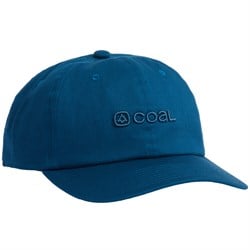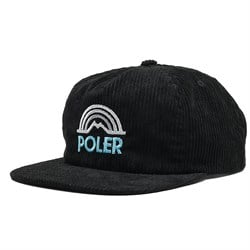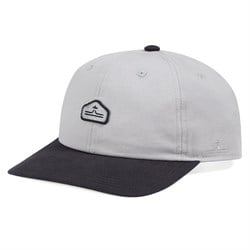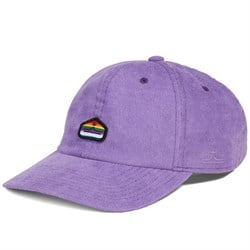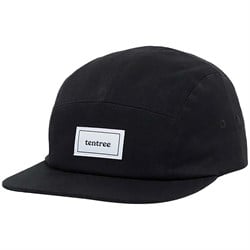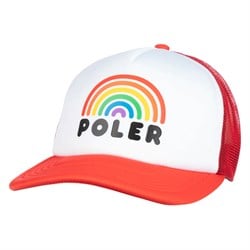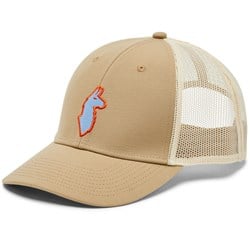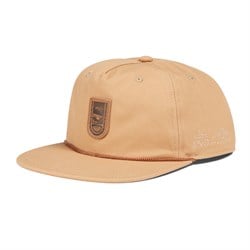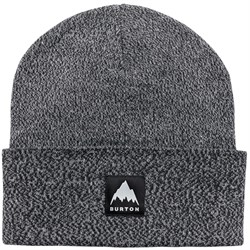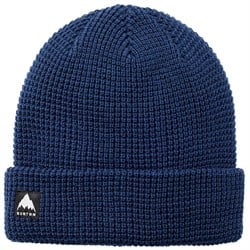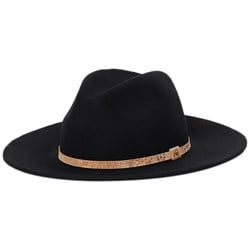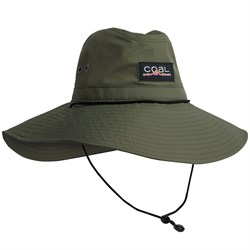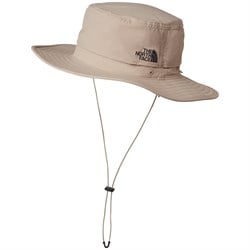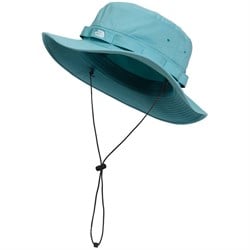How to Buy Hats: Types, Styles, & Materials
There are so many different types of hats out there from all sorts of backgrounds - it's a dizzying selection, however, this also means that there's a type of hat out there for everyone, whether you're looking for function or fashion. Sure, it's easy to spot a baseball cap, and the difference between a snapback and a strapback might be intuitive, but hop in with us and we'll have you telling your bucket from your bowler, and your cabbie from your coonskin.
A Brief History of Hats
What can we say about hats that hasn’t already been said? Historically, hats have been worn to mark social status or military rank. Straw hats have been used and made for hundreds of years by farmers to block the sun all over the globe. Hats became a common part of American culture through baseball and military use. Now that you know about the history of hats, on to the fun part.
Ball Caps or Baseball Caps
As a general rule, if it has a front facing brim and panel construction, it is a ball cap. There are many different types of ball caps based on how they adjust to your head and how they are constructed. These include fitted, snapback, strapback, flexfit, trucker and 5-panel styles.
Fitted Hats
Measure your dome and buy accordingly. Fitted hats are denoted by a size that corresponds to the circumference of your head, in inches (7 5/8", etc.). Fitted hats are most often standard baseball caps, made from 6 cloth triangles and topped with a fabric-covered button called a, yes, this is the real word, squatchee.
Snapback Hats
Snapbacks got their start in sports during the 1950s but declined as fitted hats became more popular. It wasn’t until the ’80s and ’90s that snapbacks blew up in the hip hop scene and they gained popularity across the hat-wearing world. They use plastic snaps to adjust the diameter (size) of the hat. Snapbacks can generally be found on truckers, baseball, and old school Starter style hats.
Strapbacks
Strapbacks overlap with traditional 6-panel and 5-panel hats. They are similar to snapbacks, but instead use an adjustable leather or poly band to adjust the head diameter.
Flexfit
These hats were all the rage in the ’90s (expect to see a resurgence soon). They are made out of a “poly-weave spandex” and stretch to fit your dome. One size fits most. We expect a comeback in 2020.
Trucker Hats
Trucker hats were originally used by truck drivers and farmers. Why? They were generally cheap giveaways by agricultural companies and are breathable by nature: good for working outside, which actually translates well to snow and action sports. Truckers are made with mesh and foam instead of the sweat-magnet called cotton and are generally snapbacks.
5-Panel Hats
Beanies
Beanies keep your head warm and the hair out of your face. They come in a couple of distinctive fits that can really change the vibe of your headwear. Slouch beanies, for example, can be used to store all those natty dreads. If you wear a slouch beanie, be prepared for reservoir tip comments. Skullcap style beanies are tight-fitting and give off a tough vibe; they should be accompanied by at least one facial scar (shaving, rail grind accident, they are all good). Roll up beanies do what they sound like they would and are quite versatile; wear one under a ski helmet or just around town depending on your roll preference. Pom pom beanies got their start as military wear (it’s true, call the French and Scottish) but have now been relegated to off-mountain wear for skiers and boarders (because they don’t fit under helmets), and on-mountain wear for those who don’t wear helmets. In Canada, they call beanies by their Canadian translation, a toque.
Types of Fashion Hats
Hats have a classier side, too. At evo, we consider fashion hats to include fedoras, buckets, cabbies and bowlers, to name a few. Generally, they are less casual and go well with a collared shirt or the ’50s. The longer and potentially wraparound brim is designed to protect you from sun or rain.- Bowler or Derby Hats – Charlie Chaplin loved the bowler. It has been popular in the Americas for over a hundred years, worn by the good, the bad and the ugly. The Bowler is defined by its close-fitting brim and low crown.
- Bucket Hats – From its roots in the Israeli Defense Forces of the 1940s to Gilligan's Island and 80s and 90s rap, the bucket hat has been around for a while. A recent resurgence in popularity (check out freeskiing and snowboarding) makes a lot of sense - it's an ideal hat for maximum sun protection.
- Cabbie or Ascot Hats – The Ascot is a firm, rounded short cap, usually made of wool or felt. It is also called a cabbie due to its historic use by cab drivers.
- Coonskin Cap – The play: Catch a raccoon, tame it, and convince it to sit peacefully on your head. If you can’t do that a Coonskin cap like Davy Crockett’s will work in a pinch.
- Fedora – Typically creased down the center of the crown, fedoras have a medium sized brim extending all around the hat for optimal wear protection and Depression era steeze.
- Beret – If you aren’t in the Special Forces, a craftsman of fine talent, or a French national, we recommend you avoid the beret.
- Panama – This is the straw hat you want for a vacation in the tropics. Panama hats are lightweight and made out of straw.
- Viking – The classic Viking hat has horns or wings. It is usually metal, both in material and sentiment. Viking helmets are commonly worn into battle, in the halls of Valhalla, at keggers, with excessive body hair, and during 19th century Opera.
- Shower Cap – The shower cap doesn’t get much street love these days, except from D 12 and Bizarre. However, YOU HEARD IT HERE FIRST: Shower caps are the next big craze in park rattery and park rat-ness.
Hat Materials
Hats these days come in all sorts of shapes, sizes and materials. Materials can, to some extent, limit the style of the hat. You probably won’t see too many straw flex fits or shower caps, and you can’t expect to find a nylon Viking hat – it just wouldn’t make sense.Cotton – Cotton is an everyday fabric for everyday use. Cotton shows up everywhere, and in most hats. You can think of cotton as the tomato of fabrics. Why tomato? Because tomatoes grow everywhere and are great in most salads and sandwiches.
Wool – Made from the hair of sheep, wool is soft and flexible. It is also resistant to fire, who knew? Wool can also be insulating and therefore comes in handy for hats. Wool is making a comeback with 5-panels and snapbacks, and it is also commonly seen in fashion caps.
Acrylic – There are many bonuses to an acrylic hat: resistance to sun and moths (yes, moths), plus they’re cheap and colorfast. You will find acrylic in just about every hat style for those reasons.
Felt – Usually derived from wool, felt is used to make yurts, bowler hats and fedoras - evo sells a few of these (mainly yurts, just kidding). Don’t be surprised to see felt show up in a 5-panel, as this material is making a comeback.
Nylon – Nylon is commonly used to make the mesh backs of trucker hats. Fun fact of the day: Nylon was invented in 1935 and is relatively new to the hat game. It’s made with synthetic polymers… say that 10 times fast.
Polyester – Standard Polyesthylene Teraphthalate, also known as polyester, shows up all over hats in brims, mesh and linings.
Straw – Yup, evo has straw hats. Usually found in fedora or sun hats, straw is perhaps the oldest hat material in the world!
Metal – The most shredtacular of hat materials, metal hats are commonly smithed by a large and stern man, usually missing at least one finger. If it can’t take a blow from a Viking war hammer, it’s not a metal hat.
How To Wear a Hat
- First of all, you should measure your head. It’s a good thing to know, and it will prepare you for a world of fitted caps, sized beanies and fashion hats. Measuring your head is actually a fairly simple process, take a soft tape measure and wrap it around the circumference of your head, slightly above the ears and eyebrows (about where you would wear a hat). Most hat sizes are measured in inches, centimeters, or both.
- The second step, once you have your hat: Put it on and look in the mirror. You nailed it. This is the sickest day of your life.
Learn More With Our Other Accessories Guides:
- Sunglasses - How to Choose
- Sunglasses - Style & Face Shape
- Goggles - How to Choose
- Goggles - How to Wear Goggles with Glasses
- Goggles - How to Prevent Fogging
- Helmets - How to Choose & Fit Guide
- Helmets - MIPS Technology
- Gloves & Mittens - How to Choose
- Hats - Types, Styles, & Materials
- Socks - How to Choose Ski & Snowboard Socks
Discover Our Favorite Accessories:
- The Warmest Mittens
- The Best Face Masks, Neck Tubes & Balaclavas
- The Best Ski & Snowboard Mittens
- The Best Ski & Snowboard Helmets
- The Best Kids' Ski & Snowboard Helmets
- The Best Ski & Snowboard Socks
- The Best Ski & Snowboard Gloves
- The Best Kids' Ski & Snowboard Gloves
- The Best Ski & Snowboard Goggles
- The Best Kids' Ski & Snowboard Goggles
- The Best Value Ski & Snowboard Goggles
- The Best Ski Bags
- The Best Ski & Snowboard Boot Bags
- The Best Ski & Snowboard Backpacks
- The Best Snowboard Bags
- The Best Ski & Snowboard Wax
- The Best Snowboard Stomp Pads
- The Best Ski & Snowboard Glove Liners
- The Best Snowboard Wrist Guards & Protective Gear
- The Best Heated Ski Socks & Ski Boot Heaters
- The Best Beanies
This is evo. We are a ski, snowboard, wake, skate, bike, surf, camp, and clothing online retailer with physical stores in Seattle, Portland, Denver, Salt Lake City, Whistler, and Snoqualmie Pass. Our goal is to provide you with great information to make both your purchase and upkeep easy.
evo also likes to travel to remote places across the globe in search of world-class powder turns, epic waves, or legendary mountain biking locations through evoTrip Adventure Travel Trips. Or, if you prefer to travel on your own, check out our ski & snowboard resort travel guides and mountain bike trail guides.
Still have questions? Please call our customer care team at 1.866.386.1590 during Customer Care Hours. They can help you find the right setup to fit your needs.
Learn More With Our Other Accessories Guides:
- Sunglasses - How to Choose
- Sunglasses - Style & Face Shape
- Goggles - How to Choose
- Goggles - How to Wear Goggles with Glasses
- Goggles - How to Prevent Fogging
- Helmets - How to Choose & Fit Guide
- Helmets - MIPS Technology
- Gloves & Mittens - How to Choose
- Hats - Types, Styles, & Materials
- Socks - How to Choose Ski & Snowboard Socks
Discover Our Favorite Accessories:
- The Warmest Mittens
- The Best Face Masks, Neck Tubes & Balaclavas
- The Best Ski & Snowboard Mittens
- The Best Ski & Snowboard Helmets
- The Best Kids' Ski & Snowboard Helmets
- The Best Ski & Snowboard Socks
- The Best Ski & Snowboard Gloves
- The Best Kids' Ski & Snowboard Gloves
- The Best Ski & Snowboard Goggles
- The Best Kids' Ski & Snowboard Goggles
- The Best Value Ski & Snowboard Goggles
- The Best Ski Bags
- The Best Ski & Snowboard Boot Bags
- The Best Ski & Snowboard Backpacks
- The Best Snowboard Bags
- The Best Ski & Snowboard Wax
- The Best Snowboard Stomp Pads
- The Best Ski & Snowboard Glove Liners
- The Best Snowboard Wrist Guards & Protective Gear
- The Best Heated Ski Socks & Ski Boot Heaters
- The Best Beanies
This is evo. We are a ski, snowboard, wake, skate, bike, surf, camp, and clothing online retailer with physical stores in Seattle, Portland, Denver, Salt Lake City, Whistler, and Snoqualmie Pass. Our goal is to provide you with great information to make both your purchase and upkeep easy.
evo also likes to travel to remote places across the globe in search of world-class powder turns, epic waves, or legendary mountain biking locations through evoTrip Adventure Travel Trips. Or, if you prefer to travel on your own, check out our ski & snowboard resort travel guides and mountain bike trail guides.
Still have questions? Please call our customer care team at 1.866.386.1590 during Customer Care Hours. They can help you find the right setup to fit your needs.



